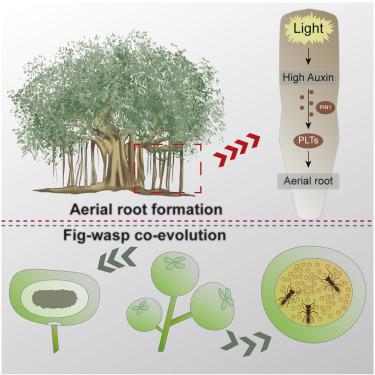Cell ( IF 45.5 ) Pub Date : 2020-10-08 , DOI: 10.1016/j.cell.2020.09.043 Xingtan Zhang , Gang Wang , Shengcheng Zhang , Shuai Chen , Yibin Wang , Ping Wen , Xiaokai Ma , Yan Shi , Rui Qi , Yang Yang , Zhenyang Liao , Jing Lin , Jishan Lin , Xiuming Xu , Xuequn Chen , Xindan Xu , Fang Deng , Lihua Zhao , Yi-lun Lee , Rong Wang , Xiao-Yong Chen , Yann-rong Lin , Jisen Zhang , Haibao Tang , Jin Chen , Ray Ming

|
Banyan trees are distinguished by their extraordinary aerial roots. The Ficus genus includes species that have evolved a species-specific mutualism system with wasp pollinators. We sequenced genomes of the Chinese banyan tree, F. microcarpa, and a species lacking aerial roots, F. hispida, and one wasp genome coevolving with F. microcarpa, Eupristina verticillata. Comparative analysis of the two Ficus genomes revealed dynamic karyotype variation associated with adaptive evolution. Copy number expansion of auxin-related genes from duplications and elevated auxin production are associated with aerial root development in F. microcarpa. A male-specific AGAMOUS paralog, FhAG2, was identified as a candidate gene for sex determination in F. hispida. Population genomic analyses of Ficus species revealed genomic signatures of morphological and physiological coadaptation with their pollinators involving terpenoid- and benzenoid-derived compounds. These three genomes offer insights into and genomic resources for investigating the geneses of aerial roots, monoecy and dioecy, and codiversification in a symbiotic system.











































 京公网安备 11010802027423号
京公网安备 11010802027423号